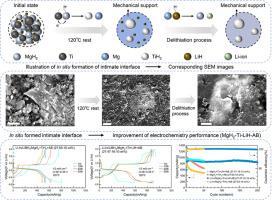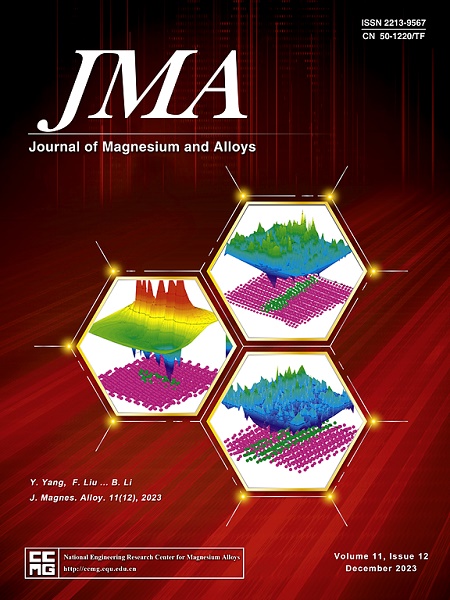In situ formation of an intimate solid-solid interface by reaction between MgH2 and Ti to stabilize metal hydride anode with high active material content
IF 15.8
1区 材料科学
Q1 METALLURGY & METALLURGICAL ENGINEERING
引用次数: 0
Abstract
MgH2 and TiH2 have been extensively studied as potential anode materials due to their high theoretical specific capacities of 2036 and 1024 mAh/g, respectively. However, the large volume changes that these compounds undergo during cycling affects their performance and limits practical applications. The present work demonstrates a novel approach to limiting the volume changes of active materials. This effect is based on mechanical support from an intimate interface generated in situ via the reaction between MgH2 and Ti within the electrode prior to lithiation to form Mg and TiH2. The resulting Mg can be transformed back to MgH2 by reaction with LiH during delithiation. In addition, the TiH2 improves the reaction kinetics of MgH2 and enhances electrochemical performance. The intimate interface produced in this manner is found to improve the electrochemical properties of a MgH2-Ti-LiH electrode. An exceptional reversible capacity of 800 mAh/g is observed even after 200 cycles with a high current density of 1 mA/cm2 and a high proportion of active material (90 wt.%) at an operation temperature of 120 °C. This study therefore showcases a new means of improving the performance of electrodes by limiting the volume changes of active materials.

通过 MgH2 和 Ti 之间的反应原位形成亲密的固-固界面,以稳定高活性材料含量的金属氢化物阳极
由于 MgH2 和 TiH2 的理论比容量分别高达 2036 mAh/g 和 1024 mAh/g,因此作为潜在的阳极材料已被广泛研究。然而,这些化合物在循环过程中发生的巨大体积变化影响了它们的性能,限制了它们的实际应用。本研究展示了一种限制活性材料体积变化的新方法。这种效应的基础是通过 MgH2 和钛在电极内发生反应形成 Mg 和 TiH2,从而在原位产生亲密界面的机械支持。在脱锂过程中,生成的 Mg 可通过与 LiH 反应变回 MgH2。此外,TiH2 还能改善 MgH2 的反应动力学并提高电化学性能。以这种方式产生的亲密界面改善了 MgH2-Ti-LiH 电极的电化学性能。在工作温度为 120 °C、电流密度为 1 mA/cm2 且活性材料比例较高(90 wt.%)的条件下,即使循环 200 次,也能观察到 800 mAh/g 的超常可逆容量。因此,这项研究展示了一种通过限制活性材料的体积变化来提高电极性能的新方法。
本文章由计算机程序翻译,如有差异,请以英文原文为准。
求助全文
约1分钟内获得全文
求助全文
来源期刊

Journal of Magnesium and Alloys
Engineering-Mechanics of Materials
CiteScore
20.20
自引率
14.80%
发文量
52
审稿时长
59 days
期刊介绍:
The Journal of Magnesium and Alloys serves as a global platform for both theoretical and experimental studies in magnesium science and engineering. It welcomes submissions investigating various scientific and engineering factors impacting the metallurgy, processing, microstructure, properties, and applications of magnesium and alloys. The journal covers all aspects of magnesium and alloy research, including raw materials, alloy casting, extrusion and deformation, corrosion and surface treatment, joining and machining, simulation and modeling, microstructure evolution and mechanical properties, new alloy development, magnesium-based composites, bio-materials and energy materials, applications, and recycling.
 求助内容:
求助内容: 应助结果提醒方式:
应助结果提醒方式:


